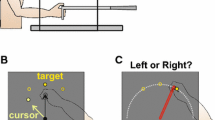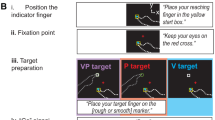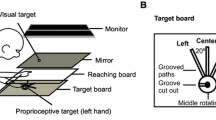Abstract
When subjects reach in a novel visuomotor environment (e.g. while viewing a cursor representing their hand that is rotated from their hand’s actual position), they typically adjust their movements (i.e. bring the cursor to the target), thus reducing reaching errors. Additionally, research has shown that reaching with altered visual feedback of the hand results in sensory changes, such that proprioceptive estimates of hand position are shifted in the direction of the visual feedback experienced (Cressman and Henriques in J Neurophysiol 102:3505–3518, 2009). This study looked to establish the time course of these sensory changes. Additionally, the time courses of implicit sensory and motor changes were compared. Subjects reached to a single visual target while seeing a cursor that was either aligned with their hand position (50 trials) or rotated 30° clockwise relative to their hand (150 trials). Reach errors and proprioceptive estimates of felt hand position were assessed following the aligned reach training trials and at seven different times during the rotated reach training trials by having subjects reach to the target without visual feedback, and provide estimates of their hand relative to a visual reference marker, respectively. Results revealed a shift in proprioceptive estimates throughout the rotated reach training trials; however, significant sensory changes were not observed until after 70 trials. In contrast, results showed a greater change in reaches after a limited number of reach training trials with the rotated cursor. These findings suggest that proprioceptive recalibration arises more slowly than reach adaptation.






Similar content being viewed by others
References
Allen TJ, Proske U (2006) Effect of muscle fatigue on the sense of limb position and movement. Exp Brain Res 170:30–38
Baraduc P, Wolpert DM (2002) Adaptation to a visuomotor shift depends on the starting posture. J Neurophysiol 88:973–981
Benson BL, Anguera JA, Seidler RD (2011) A spatial explicit strategy reduces error but interferes with sensorimotor adaptation. J Neurophysiol 105:2843–2851
Berniker M, Kording K (2008) Estimating the sources of motor errors for adaptation and generalization. Nat Neurosci 11:1454–1461
Buch ER, Young S, Contreras-Vidal JL (2003) Visuomotor adaptation in normal aging. Learn Mem 10:55–63
Cameron BD, Franks IM, Inglis T, Chua R (2012) The adaptability of self-action perception and movement control when the limb is passively versus actively moved. Conscious Cogn 21:4–17
Clayton HA, Cressman EK, Henriques DY (2014) The effect of visuomotor adaptation on proprioceptive localization: the contributions of perceptual and motor changes. Exp Brain Res 232:2073–2086
Cressman EK, Henriques DY (2009) Sensory recalibration of hand position following visuomotor adaptation. J Neurophysiol 102:3505–3518
Cressman EK, Henriques DY (2010) Reach adaptation and proprioceptive recalibration following exposure to misaligned sensory input. J Neurophysiol 103:1888–1895
Cressman EK, Salomonczyk D, Henriques DY (2010) Visuomotor adaptation and proprioceptive recalibration in older adults. Exp Brain Res 205:533–544
Desmurget M, Pelisson D, Rossetti Y, Prablanc C (1998) From eye to hand: planning goal directed movements. Neurosci Biobehav Rev 22:761–788
Diedrichsen J, White O, Newman D, Lally N (2010) Use-dependent and error-based learning of motor behaviors. J Neurosci 30:5406–5409
Flanders M, Tillery SI, Soechting JF (1992) Early stages in a sensorimotor transformation. Behav Brain Sci 15:209–320
Hadjiosif AM, Smith MA (2013a) Savings is restricted to the temporally labile component of motor adaptation. Translational and Computational Motor Control
Hadjiosif AM, Smith MA (2013b) Generalization of temporally-labile and temporally stable components of motor memory. Abstract submitted to Society for Neuroscience
Henriques DY, Cressman EK (2012) Visuomotor adaptation and proprioceptive recalibration. J Motor Behav 44:435–444
Henriques DY, Soechting JF (2003) Bias and sensitivity in haptic perception of geometry. Exp Brain Res 150:95–108
Henriques DY, Filippopulos F, Straube A, Effert T (2014) The cerebellum is not necessary for visually driven recalibration of hand proprioceptive. Neuropsychologia 64:195–204
Izawa J, Criscimagna-Hemminger SE, Shadmehr R (2012) Cerebellar contributions to reach adaptation and learning sensory consequences of action. J Neurosci 32:4230–4239
Jeannerod M (1988) The neural and behavioural organization of goal-directed movements. Clarendon Press, Oxford, UK
Kesten H (1958) Accelerated stochastic approximation. Ann Math Stat 29:41–59
Kitago T, Ryan SL, Mazzoni P, Krakauer JW, Haith AM (2013) Unlearning versus savings in visuomotor adaptation: comparing effects of washout, passage of time, and removal of errors on motor memory. Front Hum Neurosci 7:307
Krakauer JW, Ghilardi MF, Ghez C (1999) Independent learning of internal models for kinematic and dynamic control of reaching. Nat Neurosci 2:1026–1031
Krakauer JW, Pine ZM, Ghilardi MF, Ghez C (2000) Learning of visuomotor transformations for vectorial planning of reaching trajectories. J Neurosci 20:8916–8924
Krakauer JW, Ghez C, Ghilardi MF (2005) Adaptation to visuomotor transformations: consolidation, interference forgetting. J Neurosci 25:473–478
Martin TA, Keating JG, Goodkin HP, Bastian AJ, Thach WT (1996) Throwing while looking through prisms. II. Specificity and storage of multiple gaze-throw calibrations. Brain 119:1199–1211
Mattar AA, Darainy M, Ostry DJ (2013) Motor learning and its sensory effects: time course of perceptual change and its presence with gradual introduction of load. J Neurophys 109:782–791
Mazzoni P, Krakauer JW (2006) An implicit plan overrides an explicit strategy during visuomotor adaptation. J Neurosci 26:3642–3645
Miyamoto YR, Wang SX, Brennan AE, Smith MA (2014) Distinct forms of implicit learning that respond differentially to performance errors and sensory prediction errors. Translational and Computational Motor Control
Mostafa AA, Kamran-Disfani R, Bahari-Kashani G, Cressman EK, Henriques DY (2014a) Generalization of reach adaptation and proprioceptive recalibration at different distances in the workspace. Exp Brain Res 233:817–827
Mostafa AA, Salomonczyk D, Cressman EK, Henriques DY (2014b) Intermanual transfer and proprioceptive recalibration following training with translated visual feedback of the hand. Exp Brain Res 232:1639
Neva JL, Henriques DY (2013) Visuomotor adaptation and generalization with repeated and varied training. Exp Brain Res 226:363–372
Nourouzpour N, Salomonczyk D, Cressman EK, Henriques DY (2015) Retention of proprioceptive recalibration following visuomotor adaptation. Exp Brain Res 233:1019–1029
Oldfield RC (1971) The assessment and analysis of handedness: the Edinburgh inventory. Neuropsychologia 9:97–113
Pisella L, Michel C, Grea H, Tilikete C, Vighetto A, Rossetti Y (2004) Preserved prism adaptation in bilateral optic ataxia: strategic versus adaptive reaction to prisms. Exp Brain Res 156:399–408
Redding GM, Rossetti Y, Wallace B (2005) Applications of prism adaptation: a tutorial in theory and method. Neurosci Biobehav R 29:431–444
Sainburg RL, Wang J (2002) Interlimb transfer of visuomotor rotations: independence of direction and final position information. Exp Brain Res 145:437–447
Salomonczyk D, Cressman EK, Henriques DY (2011) Proprioceptive recalibration following prolonged training and increasing distortions in visuomotor adaptation. Neuropsychologia 49:3053–3062
Salomonczyk D, Henriques DY, Cressman EK (2012) Proprioceptive recalibration in the right and left hands following abrupt visuomotor adaptation. Exp Brain Res 217:187–196
Salomonczyk D, Cressman EK, Henriques DY (2013) The role of the cross-sensory error signal in visuomotor adaptation. Exp Brain Res 228:313–325
Simani MC, McGuire LM, Sabes PN (2007) Visual-shift adaptation is composed of separable sensory and task-dependent effects. J Neurophysiol 98:2827–2841
Smith MA, Ghazizadeh A, Shadmehr R (2006) Interacting adaptive processes with different timescales underlie short-term motor learning. PLoS Biol 4:e179
Taylor JA, Ivry RB (2011) Flexible cognitive strategies during motor learning. PLoS Comput Biol 7:e10001096
Taylor JA, Krakauer JW, Ivry RB (2014) Explicit and implicit contributions to learning in a sensorimotor adaptation task. J Neurosci 34:3023–3032
Treutwein B (1995) Adaptive psychophysical procedures (2014). Vision Res 35:2503–2522
Tseng Y, Diedrichsen J, Krakauer JW, shadmehre R, Bastian AJ (2007) Sensory Prediction Errors Drive Cerebellum-Dependent Adaptation of Reaching. J Neurophys 98:54–62
van Beers RJ, Wolpert DM, Haggard P (2002) When feeling is more important than seeing in sensorimotor adaptation. Curr Biol 12:834–837
Wei K, Kording K (2009) Relevance of error: what drives motor adaptation? J Neurophys 101: 655-664
Weiner MJ, Hallet M, Funkenstein HH (1983) Adaptation to lateral displacement of vision in patients with lesions of the central nervous system. Neurology 33:766–772
Yamamoto K, Hoffman DS, Strick PL (2006) Rapid and long-lasting plasticity of input output mapping. J Neurophysiol 96:2797–2801
Acknowledgments
This research was supported by a Discovery Grant from the Natural Sciences and Engineering Research Council to EKC.
Author information
Authors and Affiliations
Corresponding author
Rights and permissions
About this article
Cite this article
Zbib, B., Henriques, D.Y.P. & Cressman, E.K. Proprioceptive recalibration arises slowly compared to reach adaptation. Exp Brain Res 234, 2201–2213 (2016). https://doi.org/10.1007/s00221-016-4624-6
Received:
Accepted:
Published:
Issue Date:
DOI: https://doi.org/10.1007/s00221-016-4624-6




